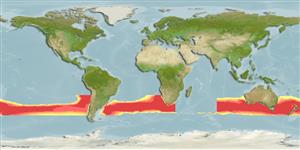Common names from other countries
>
Zeiformes (Dories) >
Oreosomatidae (Oreos) > Oreosomatinae
Etymology: Neocyttus: Greek, neos = new + Greek, kyttaros, kytos = a convex cavity.
Environment: milieu / climate zone / depth range / distribution range
экология
морской батипелагический; мигрирует в океане (Ref. 51243); пределы глубины 200 - 1240 m (Ref. 6390), usually 450 - 800 m (Ref. 30191). Deep-water; 23°S - 48°S, 81°W - 176°W
Southeast Atlantic: off Walvis Bay, Namibia to Cape Province, South Africa. Southwest Atlantic: off Argentina. Eastern Indian Ocean: southern Australia, from about 26°S in Western Australia to Broken Bay (Ref. 7300), New South Wales. Southwest Pacific: New Zealand.
Length at first maturity / Size / Вес / Возраст
Maturity: Lm 34.0, range 29 - ? cm
Max length : 40.0 cm SL самец/пол неопределен; (Ref. 30191); наибольший вес (опубликованные данные): 2.0 kg (Ref. 6390); наибольший возраст (опубликованны данные): 100 годы (Ref. 27140)
колючие лучи спинного плавника (общее число) : 7; членистые (мягкие) лучи спинного плавника (общее число) : 33 - 35; колючие лучи анального плавника: 3 - 4; членистые (мягкие) лучи анального плавника: 30 - 33. Body grey, fins dark (Ref. 6548).
Inhabit continental slopes (Ref. 9563), forming large shoals over rough ground near pinnacles and canyons (Ref. 6390). Juveniles are pelagic and tend to be dispersed over smooth grounds (Ref. 6390). Feed on salps, fish, crustaceans and squid (Ref. 27230). Eggs float near the surface and larvae also inhabit surface waters (Ref. 6390).
Life cycle and mating behavior
Maturities | размножение | Spawnings | Egg(s) | Fecundities | личинки
Displays seasonally synchronised reproduction.
Karrer, C., 1990. Oreosomatidae. p. 637-640. In J.C. Quero, J.C. Hureau, C. Karrer, A. Post and L. Saldanha (eds.) Check-list of the fishes of the eastern tropical Atlantic (CLOFETA). JNICT, Lisbon; SEI, Paris; and UNESCO, Paris. Vol. 2. (Ref. 6545)
Статус Красного Списка МСОП (Ref. 130435)
CITES (Ref. 128078)
Not Evaluated
Угроза для людей
Harmless
Использование человеком
рыболовство: не имеет хозяйственного значения
дополнительная информация
инструменты
Специальные отчеты
Скачать в формате XML
ресурсы в Интернет
Estimates based on models
Preferred temperature (Ref.
115969): 5 - 9.7, mean 7.8 (based on 131 cells).
Phylogenetic diversity index (Ref.
82804): PD
50 = 0.5635 [Uniqueness, from 0.5 = low to 2.0 = high].
Bayesian length-weight: a=0.01698 (0.00988 - 0.02919), b=3.01 (2.85 - 3.17), in cm Total Length, based on LWR estimates for this species & (Sub)family-body (Ref.
93245).
Trophic level (Ref.
69278): 3.6 ±0.53 se; based on food items.
устойчивость к внешним воздействиям (Ref.
120179): очень низкий, минимальное время удвоения популяции более 14 лет (tmax=100).
Fishing Vulnerability (Ref.
59153): High to very high vulnerability (70 of 100).
Climate Vulnerability (Ref.
125649): Moderate vulnerability (41 of 100).
